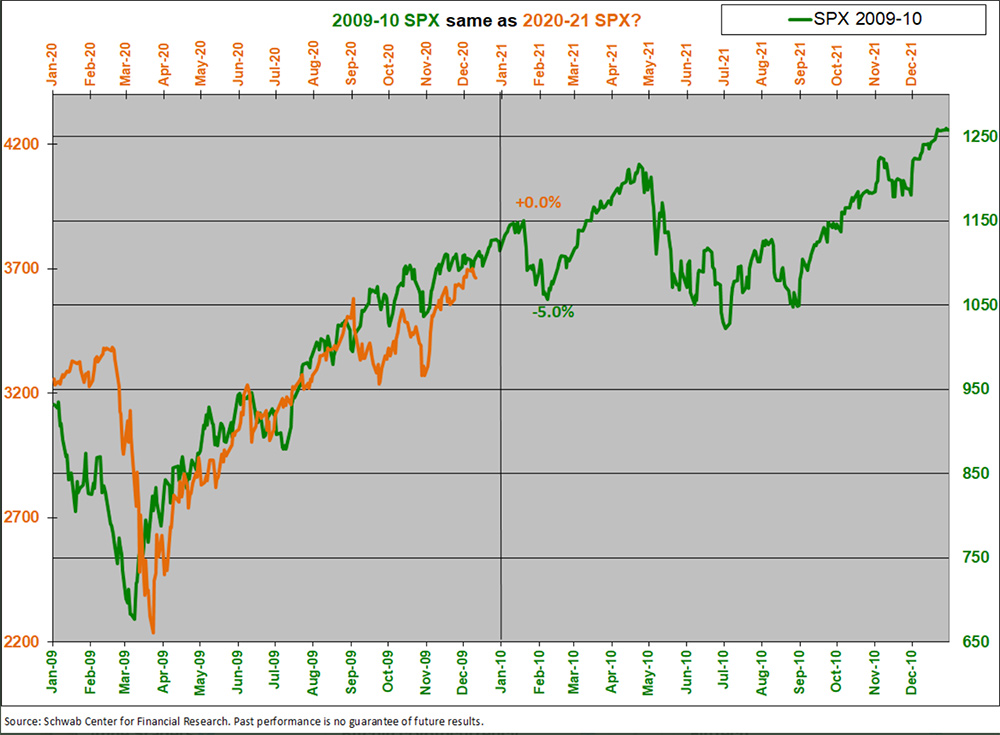几乎从所有角度看,2020年都是历史性的一年——其中也包括股市。LPL的莱恩·德特里克向《财富》杂志表示,2020年股市的疯狂波动可以用一个词来概括:“难以置信”。
“这将是历史上第一次出现年中股市一度下跌30%、最终却实现反弹走高的年份。”德特里克说,“对我来说,这意味着很多——我们从没见过像2020年这样,一年里打了个来回。”
事实上,今年3月美股以创纪录的速度迅速跌入熊市之后,已完全实现反弹,目前正处于历史高点附近,截至周二收盘,今年以来已累计上涨14%。
尽管近期股市走势有横盘趋势,但市场通常会在12月表现强劲,部分策略师认为有理由相信年底股市可能再攀高峰。
迟到的12月行情?
可以肯定的是,在股市上,历史模式并不总是可靠(2020年也时常证明这一点)。
但LPL的德特里克指出,历史上看(从1950年的标准普尔500指数算起),12月下半月市场往往表现十分强劲。
股市往往在12月表现强劲,不过圣诞老人要到下半月才来。
- 莱恩·德特里克, CMT (@RyanDetrick),2020年12月11日
他说,12月股市平均涨幅约为1.5%,但“几乎所有”行情都始于12月15日。
他说,即使2020年一直不可预测,“我们认为今年也不会违背12月规律。”这是因为,疫苗开始配送,经济刺激法案可能通过,交易员和投资者开始休圣诞假期,德特里克认为交易量和波动性应该不大。他说:“这可能促成年底实现小幅上涨,也就是历史上常见的圣诞行情。”
嘉信理财(Charles Schwab)的首席投资策略师利兹·安·桑德斯则表示,随着2021年即将到来,主要存在两种尾部风险:一是“情况甚至比我们期望的更好,”这可能导致“经济增长过热,通货膨胀更严重,将美联储置于“他们是否不得不放弃宽松政策?’的困境中。”桑德斯向《财富》杂志表示,“另一个极端则完全相反:我们做了一系列非常积极的假设,如果其中几个或好几个假设不对怎么办?”
为回调做好准备
事实上,一些华尔街人已经对市场过热感到不安,担心很可能会出现抛售——或者至少是暂缓的情况。
许多策略师都注意到了很重要的一点,今年行情与2009年的牛市惊人相似。(详见下面嘉信金融研究中心的图表。)一些策略师表示,这张图预示着前面可能会出现一些动荡。

嘉信理财交易和衍生品副总裁兰迪·弗雷德里克在最近的一条推特上写道:“没有人知道2021年是否还会沿着这张图走,但如果会,1月下半月看起来有点令人担忧。”
但即使2021不继续遵循2009-2010的曲线图,LPL的德特里克认为,过去几个月市场上一些“破纪录的表现”,“可以这么说,可能偷了一点明年的收益。”他认为“最令人担心的”是估值。他认为,2021年第一季度出现10%左右的修正将是合理的,建议投资者考虑调仓,重新实现平衡。
但与此同时,嘉信理财的桑德斯认为,从现在到2021年,投资者可能会学到一个相当重要的教训:“我认为市场不应该依赖于美联储总是会支持市场这样的假设,”她说。
“等下次市场回调时——虽然我不知道是什么时候,但总会调整的——如果下次回调不会威胁到金融系统稳定,也不是由危机引发的,我想我们不能再依赖所谓的‘鲍威尔卖权’了,不能认为美联储会永伴身侧,为市场提供支撑。”桑德斯说,“2021年,我们必须要关注这一点。”(财富中文网)
译者:Agatha
几乎从所有角度看,2020年都是历史性的一年——其中也包括股市。LPL的莱恩·德特里克向《财富》杂志表示,2020年股市的疯狂波动可以用一个词来概括:“难以置信”。
“这将是历史上第一次出现年中股市一度下跌30%、最终却实现反弹走高的年份。”德特里克说,“对我来说,这意味着很多——我们从没见过像2020年这样,一年里打了个来回。”
事实上,今年3月美股以创纪录的速度迅速跌入熊市之后,已完全实现反弹,目前正处于历史高点附近,截至周二收盘,今年以来已累计上涨14%。
尽管近期股市走势有横盘趋势,但市场通常会在12月表现强劲,部分策略师认为有理由相信年底股市可能再攀高峰。
迟到的12月行情?
可以肯定的是,在股市上,历史模式并不总是可靠(2020年也时常证明这一点)。
但LPL的德特里克指出,历史上看(从1950年的标准普尔500指数算起),12月下半月市场往往表现十分强劲。
股市往往在12月表现强劲,不过圣诞老人要到下半月才来。
- 莱恩·德特里克, CMT (@RyanDetrick),2020年12月11日
他说,12月股市平均涨幅约为1.5%,但“几乎所有”行情都始于12月15日。
他说,即使2020年一直不可预测,“我们认为今年也不会违背12月规律。”这是因为,疫苗开始配送,经济刺激法案可能通过,交易员和投资者开始休圣诞假期,德特里克认为交易量和波动性应该不大。他说:“这可能促成年底实现小幅上涨,也就是历史上常见的圣诞行情。”
嘉信理财(Charles Schwab)的首席投资策略师利兹·安·桑德斯则表示,随着2021年即将到来,主要存在两种尾部风险:一是“情况甚至比我们期望的更好,”这可能导致“经济增长过热,通货膨胀更严重,将美联储置于“他们是否不得不放弃宽松政策?’的困境中。”桑德斯向《财富》杂志表示,“另一个极端则完全相反:我们做了一系列非常积极的假设,如果其中几个或好几个假设不对怎么办?”
为回调做好准备
事实上,一些华尔街人已经对市场过热感到不安,担心很可能会出现抛售——或者至少是暂缓的情况。
许多策略师都注意到了很重要的一点,今年行情与2009年的牛市惊人相似。(详见下面嘉信金融研究中心的图表。)一些策略师表示,这张图预示着前面可能会出现一些动荡。
嘉信理财交易和衍生品副总裁兰迪·弗雷德里克在最近的一条推特上写道:“没有人知道2021年是否还会沿着这张图走,但如果会,1月下半月看起来有点令人担忧。”
但即使2021不继续遵循2009-2010的曲线图,LPL的德特里克认为,过去几个月市场上一些“破纪录的表现”,“可以这么说,可能偷了一点明年的收益。”他认为“最令人担心的”是估值。他认为,2021年第一季度出现10%左右的修正将是合理的,建议投资者考虑调仓,重新实现平衡。
但与此同时,嘉信理财的桑德斯认为,从现在到2021年,投资者可能会学到一个相当重要的教训:“我认为市场不应该依赖于美联储总是会支持市场这样的假设,”她说。
“等下次市场回调时——虽然我不知道是什么时候,但总会调整的——如果下次回调不会威胁到金融系统稳定,也不是由危机引发的,我想我们不能再依赖所谓的‘鲍威尔卖权’了,不能认为美联储会永伴身侧,为市场提供支撑。”桑德斯说,“2021年,我们必须要关注这一点。”(财富中文网)
译者:Agatha
This year was a historic year by pretty much all measures—and that includes the stock market. To those like LPL's Ryan Detrick, the market's wild moves in 2020 can be summed up in one word: "Unbelievable," he tells Fortune.
"This is going to be the first year in history that stocks were down 30% for the year at one point and managed to finish higher," Detrick says. "That, to me, summarizes a lot—We’ve never seen a round-trip like 2020."
Indeed, after a record-fast plunge into a bear market in March, stocks have managed to completely recover and are currently trading around all-time highs, up 14% for the year at Tuesday's close.
Though stocks of late have traded rather sideways, December is typically a strong month for investors, and some strategists see reason to believe stocks might close out the year on a high note.
A late December rally?
To be sure, historical patterns don't always hold up when it comes to the market (that's been true of 2020 at times as well).
But LPL's Detrick points out that historically (going back to 1950 for the S&P 500), the latter half of December tended to be strong for investors.
December is usually a strong month for stocks, but Santa doesn't show until the second half of the month. pic.twitter.com/MLcAMnUZp9
— Ryan Detrick, CMT (@RyanDetrick) December 11, 2020
He says on average December is up approximately 1.5%, but "nearly all" the gains tend to build from Dec. 15 on.
And even though 2020 has been unpredictable to say the least, "We wouldn’t want to bet against that this year," he says. That's because with a vaccine starting to be distributed, a stimulus bill likely to be passed, and traders and investors beginning to take vacation for the holidays, Detrick believes volume and volatility should be light. "That can lead to a little bit of a higher move into the end of the year, this historical Santa Claus rally," he says.
Others like Charles Schwab's chief investment strategist Liz Ann Sonders note that going into 2021, there are two main tail risks: One is that "things are even better than what we expect," which could create the "possibility of overheating growth, maybe more inflation, and putting the Fed in a pickle in terms of, 'do they have to back away from this easy policy?'," Sonders tells Fortune. "The other extreme would be the opposite: That we built in a pretty positive set of assumptions, and what if several or a bunch of them go wrong?"
Prepare for a pullback
Indeed, some on Wall Street are already antsy that the markets have gotten overheated and a sell off—or at least pause—might be in the cards.
One big theme many strategists noticed this year was its eerie similarity to the 2009 bull market. (See chart via Schwab Center for Financial Research below.) And according to some strategists, that map could be signaling some turbulence ahead.
"No one knows if the roadmap will continue into 2021, but if it does, the latter half of January looks a bit worrisome," Charles Schwab's vice president of trading and derivatives Randy Frederick wrote in a recent tweet.
But even if 2021 doesn't continue to follow the 2009-10 map, LPL's Detrick believes some of the "record run" of the past several months in the market "might be stealing, if you will, a little bit from some of the gains next year," he says, pointing to valuations as one of the "biggest concerns." He thinks something like a 10% correction would make sense in the 1st quarter of 2021, and suggests investors consider rebalancing with moves up or down.
But in the meantime, Schwab's Sonders believes investors can glean a pretty big lesson from 2020 heading into next year: "I don't think the market should rest on an assumption that the Fed is always going to have the market’s back," she says.
"When we get the next correction—and we’ll get one, I don’t know when—if it doesn’t threaten financial systems stability, if it’s not crisis-driven, I don't think we can rely on the so-called 'Powell Put,' that the Fed’s just always going to be there," Sonders says. "We have to be mindful of that in 2021."






